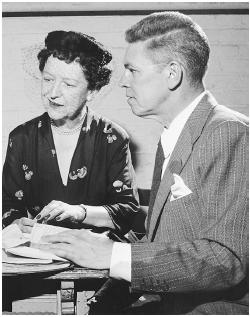Frances Goodrich and Albert Hackett - Writer
GOODRICH. Writer. Nationality: American. Born: Belleville, New Jersey, 1891. Education: Attended Passaic Collegiate High School, graduated 1908; Vassar College, Poughkeepsie, New York, graduated 1912; New York School of Social Work, 1912–13. Family: Married 1) the actor Robert Ames, 1917 (divorced 1923); 2) the writer Henrik Willem Van Loon, 1927 (divorced 1930); 3) Albert Hackett, 1931. Died: Of cancer in New York City, 19 January 1984.
HACKETT. Writer. Nationality: American. Born: New York City, 16 February 1900. Education: Attended Professional Children's School, New York, 1914–16. Died: Of pneumonia 16 March 1995.
Both Goodrich and Hackett were actors: Goodrich made her stage debut in Massachusetts in 1913, and her Broadway debut in Come Out of the Kitchen , 1916; Hackett acted on stage and in films as a child;

Films as Writers:
- 1933
-
The Secret of Madame Blanche (Brabin); Penthouse ( Crooks in Clover ) (Van Dyke)
- 1934
-
Fugitive Lovers (Boleslawsky) (co); The Thin Man (Van Dyke); Hide-Out (Van Dyke)
- 1935
-
Naughty Marietta (Van Dyke) (co); Ah, Wilderness! (Brown)
- 1936
-
Rose Marie (Van Dyke) (co); Small Town Girl (Wellman) (co); After the Thin Man (Van Dyke)
- 1937
-
The Firefly (Leonard)
- 1939
-
Another Thin Man (Van Dyke); Society Lawyer (Ludwig) (co)
- 1943
-
Doctors at War (Shumlin—short)
- 1944
-
Lady in the Dark (Leisen); The Hitler Gang (Farrow)
- 1946
-
The Virginian (Gilmore); It's a Wonderful Life (Capra) (co)
- 1948
-
The Pirate (Minnelli); Summer Holiday (Mamoulian); Easter Parade (Walters) (co)
- 1949
-
In the Good Old Summertime (Leonard) (co)
- 1950
-
Father of the Bride (Minnelli)
- 1951
-
Father's Little Dividend (Minnelli); Too Young to Kiss (Leonard)
- 1954
-
Give a Girl a Break (Donen); Seven Brides for Seven Brothers (Donen) (co); The Long, Long Trailer (Minnelli)
- 1956
-
Gaby (Bernhardt) (co)
- 1958
-
A Certain Smile (Negulesco)
- 1959
-
The Diary of Anne Frank (Stevens)
- 1962
-
Five Finger Exercise (Daniel Mann)
- 1980
-
The Diary of Anne Frank (Sagal)
Films as Actor (Hackett):
- 1919
-
Come Out of the Kitchen (Robertson); Anne of Green Gables (Taylor)
- 1921
-
Molly O' (Jones); The Good-Bad Wife (McCord)
- 1922
-
The Country Flapper (Jones); The Darling of the Rich (Adolfi); A Woman's Woman (Giblyn)
- 1930
-
Whoopee! (Freeland)
Publications
By GOODRICH and HACKETT: plays—
Up Pops the Devil , New York, 1933.
The Great Big Doorstep , Chicago, 1943.
The Diary of Anne Frank , New York, 1958.
On GOODRICH and HACKETT: articles—
Film Comment (New York), Winter 1970–71.
Films in Review (New York), October 1977.
Ahrlich, Evelyn, in American Screenwriters , edited by Robert E. Morsberger, Stephen O. Lesser, and Randall Clark, Detroit, Michigan, 1984.
Francke, Lizzie, " Father of the Bride, " in Sight and Sound (London), March 1992.
Obituary on Hackett, in The Washington Post , 19 March 1995.
Obituary on Hackett, in Time , 27 March 1995.
Obituary on Hackett, in Variety (New York), 3–9 April 1995.
Obituary on Hackett, in Psychotronic Video (Narrowsburg), no. 21, 1995.
* * *
Although the screenwriting team of Frances Goodrich and Albert Hackett received critical and popular acclaim for the 1959 adaptation of their Pulitzer Prize-winning stage play, The Diary of Anne Frank , most of their creative efforts were not "serious" works. Schooled in the sophisticated stage comedies of the late 1920s and early 1930s, Goodrich and Hackett adapted The Thin Man in 1934, and it is a work now as then considered to be the best of the cinema's detective comedies. They followed this exceptional adaptation with an excellent After the Thin Man and an effective Another Thin Man , in both of which they succeeded in translating the work of Dashiell Hammett to the screen while managing to maintain the quality of his stories. They were equally adept at musicals. In the 1930s they adapted two vehicles for Jeanette MacDonald and Nelson Eddy, Naughty Marietta and Rose Marie , reworking some of the stilted dialogue from the stage versions so that it was both more contemporary and more fluid. As well, the pair produced two splendid screen musicals—the flashy, colorful The Pirate in the late 1940s and the innovative Seven Brides for Seven Brothers in the mid-1950s.
Unusual in the couple's credits is Frank Capra's It's a Wonderful Life , a film that, in its warmth and humanity, seems more likely to have been the work of Robert Riskin, Capra's frequent collaborator, than that of the Hacketts. Critics now regard It's a Wonderful Life as an outstanding achievement—for its screenplay as well as for its execution. It was certainly a major film in Capra's career (coming ironically just when his fortunes were on the wane with the Hollywood establishment), and it is certainly the Hacketts's most significant contribution to film art.
Wonderful Life , Anne Frank , the subtleties of The Thin Man , and the fresh handling of plot and character in the designed-for-the-screen musicals, The Pirate and Seven Brides , all serve to suggest that Goodrich and Hackett still remain the most eclectic screenwriters that Hollywood has produced. Their scope has not yet been matched by any other team.
—Donald W. McCaffrey
Comment about this article, ask questions, or add new information about this topic: